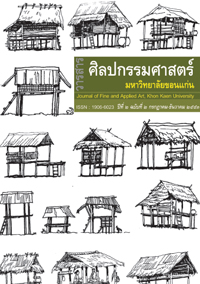เพลงพรพรหม – จูบเย้ยจันทร์ ต้นรากสำคัญจาก แขกมอญบางขุนพรหม
Main Article Content
Abstract
บทความเรื่องนี้ ผู้เขียนมุ่งอธิบายเรื่องราวของเพลงร้อง ๒ เพลง คือ เพลงพรพรหม และเพลงจูบเย้ยจันทร์ ว่ามีที่มาหรือต้นรากจากเพลงแขกมอญบางขุนพรหม อันเป็นเพลงไทยในขนบเป็นสำคัญ ทั้งนี้ผู้เขียนได้แสดงที่มาเพลงแขกมอญบางขุนพรหม ว่าได้รับอธิพลจากเพลง “แขกมอญ” ผลงานของ พระประดิษฐ์ไพเราะ (มี ดุริยางค์กูร) นักดนตรีคนสำคัญแห่งกรุงรัตนโกสินทร์ ในประเด็นของ ความสัมพันธ์ทางสังคีตลักษณ์ การใช้สำเนียงมอญระคนในเพลงทุกท่อน เหล่านี้อันแสดงถึงอิทธิพลของเพลง “แขกมอญ” ที่ก่อให้เกิดงานดนตรีที่งดงามและไพเราะในยุคต่อมา
ในสมัยถัดมามีการนำเพลงแขกมอญบางขุนพรหม มาประยุกต์ใหม่ให้เข้ากับสังคมในขณะนั้น โดยนำเพลงดังกล่าวมาปรุงใหม่ เกิดเป็น “เพลงพรพรหม” ในอัตราจังหวะสองชั้น และ “เพลงจูบเย้ยจันทร์” ในอัตราจังหวะชั้นเดียว เป็นที่ได้รับความนิยมของผู้คนในสมัยนั้น ด้วยทำนองคุ้นหูและท่วงทีการร้องที่น่าฟัง การดังกล่าวย่อมสะท้อนให้เห็นถึงความเป็นอมตะของผลงาน และภูมิปัญญาอันยิ่งของโบราณจารย์ ที่สร้างสรรค์งานศิลปะได้อย่างเป็นเลิศ ผ่านการพิสูจน์ความเป็นเพชรนํ้าเอกของงาน แม้จะผ่านระยะเวลาที่ยาวนาน ก็ยังทรงไว้ซึ่งคุณงามไม่เสื่อมคลายดุจเพลงแขกมอญบางขุนพรหมฉะนี้
Pleng Ponn Phrom and Pleng Joop Ya – yeoy Chan were derived from the traditional tune named Plang Khak Mon Bang Khun Phrom
In this article, the author aims to illustrate that the melodies of Pleng Ponn Phrom and those of Pleng Joob Ya-yeoy Chan were derived from the traditional tune named Pleng Khak Mon Bang Khun Phrom. The author further shows that the origin of the Pleng Khak Mon Bang Khun Phrom was from the traditional tune called Khak Mon of Phra PraditPairoh (Mee Duriyangura), one of the greatest composers in the Rattanakosin period. The relationships between these four melodies are obvious in that all melodies were influenced by the usage of Monaccents.
In later period, Pleng Khak Mon Bang Khun Prom was adapted to cater contemporary Thai audience by selecting only the song chan version (moderate tempo) of Pleng Khak Mon Bang Khun Phrom and the chan deo version (fast tempo) of the same song to make two new tunes known as Pleng Ponn Phrom and Pleng Joob Ya-Yeoy Chan. Both of the new tunes were widely accepted because of the familiar melodies and beautiful styles of vocal melodies. This reflects the immortality of the work and the wisdom of Thai classical music masters who were capable of rendering everlasting pieces of great music through timeArticle Details
Content and information in articles published in the Journal of Fine and Applied Arts of Khon Kaen University is regarded as the opinion and sole responsibility of the author(s) directly; therefore, editors are not obliged to agree to or share any responsibility with regard to the content and information that appears within these articles.
All articles, information, content, image, etc. that have been published in the Journal of Fine and Applied Arts of Khon Kaen University is the copyright of the Journal of Fine and Appllied Arts of Khon Kaen University. Any person or organization who wishes to distribute all or parts of the articles for further dissemination or other usage must first receive permission from the Journal of Fine and Applied Arts of Khon Kaen University before proceeding to do so.


